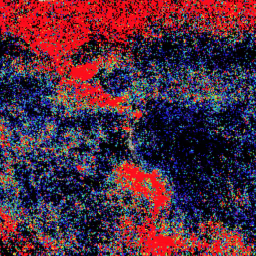Explore the dataset catalogue
Access a range of data types, essential for robust environmental and climate analyses, from premium and open-access providers. For each dataset, we offer the detailed insights you need — complete with links to scientific research and licensing details — to help you select the right data for your analysis.

image to
follow
RESOLVE Ecoregions 2017
The RESOLVE Ecoregions dataset, updated in 2017, offers a depiction of the 846 terrestrial ecoregions that represent our living planet.

image to
follow
SMAP Soil Moisture (11km)
Global 3-hourly, level 4, surface and root zone soil moisture dataset

image to
follow
SRTM Digital Elevation Data 2000 (90m)
A near-global elevation map. Good for regional analysis of topography or visual hillshading.

image to
follow
Sentinel-1 SAR GRD
Weekly near-global radar coverage of land surface and coastal zones. Suitable for mapping land cover, cropland classifications, detecting ships and sea ice, forest disturbance, etc.

image to
follow
Sentinel-2 MultiSpectral
Weekly near-global coverage of visible and infrared data of land surface and coastal zones, with missing data for cloudy areas. Suitable for land cover classification including cropland and forestry.

image to
follow
Sentinel-2: Cloud Probability
The S2 cloud probability created with the sentinel2-cloud-detector library.

image to
follow
Sentinel-5P NRTI NO2 – Near Real-Time Nitrogen Dioxide (1.1km)
Near real-time global maps of atmospheric NO2 concentrations.

image to
follow
Sentinel-5P: Carbon Monoxide (1.1km)
Offline' (not near real-time), high-resolution imagery of CO concentrations, which is useful for exploring combustion of fossil fuels, biomass burning, and atmospheric oxidation of methane and other hydrocarbons.

image to
follow
Sentinel-5P: Formaldehyde (1.1km)
Offline' (not near real-time), high-resolution imagery of atmospheric formaldehyde (HCHO) concentrations, an intermediate gas in almost all oxidation chains of non-methane volatile organic compounds, leading eventually to carbon dioxide.

image to
follow
Sentinel-5P: Methane (1.1km)
Offline' (not near real-time), high-resolution imagery of methane concentrations, which is the second most important contributor to the anthropogenically enhanced greenhouse effect after carbon dioxide.

image to
follow
Sentinel-5P: Nitrogen Dioxide (1.1km)
Offline' (not near real-time), high-resolution imagery of atmospheric NO2 concentrations.

image to
follow
Sentinel-5P: Sulfur Dioxide (1.1km)
Offline' (not near real-time), high-resolution imagery of atmospheric sulfur dioxide (SO2) concentrations, which plays a role in chemistry on a local and global scale and its impact ranges from short-term pollution to effects on climate.

image to
follow
Sentinel-5P: UV Aerosol Index (1.1km)
Offline' (not near real-time), high-resolution imagery of the UV Aerosol Index (UVAI), also called the Absorbing Aerosol Index (AAI), which is useful for tracking the evolution of aerosol plumes of dust, ash, or smoke.

image to
follow
TOMS and OMI Merged Ozone Data (~100km)
The Total Ozone Mapping Spectrometer (TOMS) data on ~1 degree grid, for use in monitoring global and regional trends in total ozone over the past 25 years.

image to
follow
USFS Landscape Change Monitoring System (30m)
Change, land cover, and land use outputs from the LCMS data suite with US coverage only for years 1985-2022.

image to
follow
USGS National Map DEM (10m)
Seamless DEM dataset with full coverage for the continental US states and partial coverage of Alaska, generated with data from 1998-2020.

image to
follow
VIIRS Stray Light Corrected Nighttime Day/Night Band Composites (500m)
Monthly global map of nighttime lights at 500m from 2014 – present, with a three month delay, with some cloud impact. Can be used as a proxy for population density and development.

image to
follow
WHRC Pantropical National Level Carbon Stock 2012 (500m)
Map of above-ground live woody biomass at 500m for tropical countries for the year 2012.

image to
follow
WWF HydroATLAS Basins Level 10
Detailed hydro-environmental information about the world's watersheds at high spatial resolution.

image to
follow
WWF HydroSHEDS Void-Filled DEM 3 Arc-Seconds (90m)
A near-global elevation map. Good for regional analysis of topography or visual hillshading. This data has been optimised for hydrological studies.

image to
follow
WorldPop Global Project Population Data (93m)
Population distrubtion for years 2000-2021 with global coverage.
































